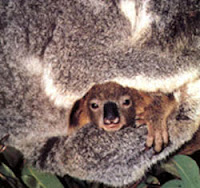 Because the environment exerts such control over the adaptations that arise by natural selection-including the co-adaptations of different species evolving together, such as flowers and pollinators-the kind of organism that would fill a particular environmental niche ought to be predictable in general terms. An example of this process of adaptive radiation, or filling out of environmental niches by the development of new species, is provided by Australia. When Australia became a separate continent some 60 million years ago, only monotremes and marsupials lived there, with no competition from the placental mammals that were emerging on other continents. Although only two living monotremes are found in Australia today, the marsupials have filled most of the niches open to terrestrial mammals on that continent. Because Australian habitats resemble those in other parts of the world, marsupial equivalents can be found to the major placental herbivores, carnivores, and even rodents and moles.
Because the environment exerts such control over the adaptations that arise by natural selection-including the co-adaptations of different species evolving together, such as flowers and pollinators-the kind of organism that would fill a particular environmental niche ought to be predictable in general terms. An example of this process of adaptive radiation, or filling out of environmental niches by the development of new species, is provided by Australia. When Australia became a separate continent some 60 million years ago, only monotremes and marsupials lived there, with no competition from the placental mammals that were emerging on other continents. Although only two living monotremes are found in Australia today, the marsupials have filled most of the niches open to terrestrial mammals on that continent. Because Australian habitats resemble those in other parts of the world, marsupial equivalents can be found to the major placental herbivores, carnivores, and even rodents and moles.
 This pattern can be observed on a restricted scale as well. sparsely populated islands for example, one species of bird might enterIn some the region, find little or no competition, and evolve rapidly into a number of species adapted to the available niches. A well-known instance of such adaptive radiation was discovered by Charles Darwin in Galapagos Islands. He presumed, probably correctly, that one species of finch colonized the islands thousands of years ago and gave rise to the 14 species of finch-like birds that exist there now. Thus, one finch behaves like a warbler, another like a woodpecker, and so on. The greatest differences in their appearance lie in the shapes of the bills, adapted to the types of food each species eats.
This pattern can be observed on a restricted scale as well. sparsely populated islands for example, one species of bird might enterIn some the region, find little or no competition, and evolve rapidly into a number of species adapted to the available niches. A well-known instance of such adaptive radiation was discovered by Charles Darwin in Galapagos Islands. He presumed, probably correctly, that one species of finch colonized the islands thousands of years ago and gave rise to the 14 species of finch-like birds that exist there now. Thus, one finch behaves like a warbler, another like a woodpecker, and so on. The greatest differences in their appearance lie in the shapes of the bills, adapted to the types of food each species eats.
skip to main |
skip to sidebar
Thinking is the beginning of enlightenment, which brings a huge impact and change in human life. Non-realize thinking are considered as resources that will not guide someone to attain wisdom. The wisdom has transformed into words without subjectivity and completely without object, which penetrates the equality of all things, is undifferentiated.









6 comments:
So cute... I want those animals. I wish I could huge them.
Thanks for the comment. If you wanna have it, you can go to Australia. Nice trip.
Yes they do have amazing animals there. I am mad about kangaroos and get upset when reading of their abuse by some Australians but I suppose every country has it's cruel types.
Very informative!! keep it up bro
I recognize the wombat and the platypus. What is the animal at the bottom? A baby kangaroo?
Great blog suray.
Hi Russel, thanks for your comment. One of the picture above is the baby of Koala.
Post a Comment